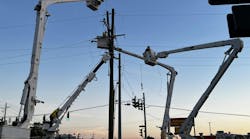Ice often encapsulates the power lines in Manitoba, where temperatures can dip below -40°C in the wintertime. The Canadian province can get up to 132 days a year of snowfall greater than 1 cm, and brutal weather conditions can wreak havoc on the infrastructure.
Like other parts of North America, however, the ice in Manitoba can be very intermittent. The province can go for years without having any ice, but at other times, Manitoba Hydro's power line technicians (PLTs) may have to deal with icy power lines around the clock for weeks.
For ice to accumulate on a power line, it must be close to 0°C, and there must be moisture in the air. If the moisture is blowing, ice can build up on one side of the conductor more than the other. The line can then behave like an airplane wing and start galloping up and down, causing crossarms to rip off and poles to break. More severe icing of conductors on steel transmission lines can cause the towers to buckle and the structure to fail.
Oftentimes, it's not the sheer weight of the ice on the power line but rather the way it goes up and down that can inflict the real damage. Over the years, Manitoba Hydro's crews have tried a variety of techniques to strike, beat, crack and melt the ice off of the power lines.
De-Icing the Infrastructure
To remove this ice from the power lines, Manitoba Hydro's power line technicians (PLTs) formerly relied on a club or stick. Field crews also used an ice roller, an upside-down pulley attached to a wooden stick with a fiberglass insert for an energized line. Linemen would pull down on the rope by hand and use the ice roller to apply pressure to roll ice off the line.
This method is still effective depending upon how much ice is on the line and how it was formed. If it is clear and brittle, it can come off easily, but if the temperature is hovering around 0°C and the ice is soft and flexible, then this approach often doesn't work.
In the mid-1980s, Manitoba Hydro came up with the idea of melting the ice off the line. To accomplish this task, the affected section of line would be de-energized, a three-phase short would be installed at a calculated distance from the ice-melt source supply, and the line would be energized with typically a 12 kV distribution voltage. The current generated by the short circuit would then cause the ice to melt off the conductor.
Responding to Severe Weather
When severe weather hits, Manitoba Hydro's staff work together to remove the ice from the line before major damage occurs. If Mother Nature cooperates and the temperature rises over freezing, there is less to worry about. Daytime heating from the sun and milder temperatures can remove ice from the lines naturally. Conversely, if the weather changes quickly to -20°C or below, sufficient heat cannot be maintained in the conductor to effectively melt the ice. As such, the ideal melting temperatures are between 0°C to -15°C.
Requests to perform ice melts originate from the local district operating staff based on observed conditions in their area. They in turn route the requests to the Emergency Operations Center (EOC). The EOC contains key staff from multiple disciplines who coordinate the activities and resources to perform ice melts, ice rolling and repairs during major storms.
Manitoba Hydro has several EOCs, but the two generally involved with ice storm activities are located in the eastern and western areas of the province. They are equipped as stand-alone EOCs that function during times of major outages to restore power to their customers by coordinating and directing restoration efforts of field staff.
Putting the Plan into Action
It used to be time-consuming and labor-intensive to get the ice off of the line. Now, once Manitoba Hydro has the proper workers in place, they can melt the ice off of the line in about 10 minutes. Facilities have been installed and improved to shorten the time required to perform ice-melting activities.
In some cases, the PLTs will break up into teams to conduct ice rolling and/or ice-melting procedures for maximum benefit. At other times, the technicians will man the station while the PLTs will work with the EOC and control center to conduct the switching to isolate the line and perform the melt.
Over the years, the crews have refined this process. The engineers all know where the shorting switches are located, and they have identified which stations have the capability to melt ice. The ice-melt cases are already done, making it easier to perform the procedure when the time comes. Information regarding conductor sizes, lengths and ice-melt current capabilities are all documented and available. History regarding previous melts is stored and available to quickly determine success or problems experienced in previous situations.
The amount of current required to melt the ice depends upon the temperature, wind speed, wind direction, amount of ice on the line, length of the line and size of the conductor.
To help with this process, Manitoba Hydro has its own ice-melt weather stations located at the substations. The weather stations were installed in the ice-prone areas first and then expanded to cover more of the province. The utility has seen most of the severe ice in the southern areas, with some regions having had more ice problems than others. This has changed over the years with ice conditions occurring more widespread geographically and moving further north. For example, a crew in Churchill, Manitoba (adjacent to Hudson Bay, in the extreme northeast corner of Manitoba), is slowly growing and expanding all of its ice-melt capabilities.
Gaining a Visual Perspective
The original weather reporting stations were somewhat off-the-shelf packages that gathered data, reported it to a central station and alarmed for variances beyond preset limits. Recently, Manitoba Hydro has developed a new Ice Vision system, which incorporates live camera images in addition to all the normal weather data points. These cameras are connected to a communications system, which allows Manitoba Hydro staff to get a real-time view of the ice accumulation. These images, along with the relevant weather data, are stored and retrievable to compare accumulation relative to time.
The cameras are protected in weatherproof housings and pointed directly at the power lines. To get a clear view of the severity of the ice, the utility relies on two methods: field crew members' observations and reports, and the pictures from the digital cameras. The digital images allow the technicians to determine the thickness of the ice in millimeters and whether it is clear, hard and brittle, or soft and cloudy.
Manitoba Hydro first installed the cameras as a pilot project. In the beginning, the utility focused on installing them in areas most prone to ice damage, but because of the success, is considering adding more cameras to other locations.
Preparing for Future Ice Storms
Over the years, Manitoba Hydro has changed the way it has melted ice on the lines. The PLTs formerly did this only on the sub-transmission system, but the field crews and engineers recently have found a way to melt the ice on the distribution lines as well. To make this process even more efficient, the company is working toward new stations with a capacity to melt ice on the transmission lines.
In the past, the field crews also were restricted by the size of the conductor. If it was a large transmission conductor, there wasn't enough ampacity to heat up and melt the ice. Manitoba Hydro is now building additional capacity into some of the newer stations and has retrofitted some of the older stations with a dedicated ice-melt bank.
Over the last few decades, Manitoba Hydro has started installing shorting switches. That way, the PLTs no longer have to perform this work by hand. Instead, the company has progressed into dedicated banks for melting the ice.
The PLTs also no longer need to de-energize a part of the town for an ice-melting procedure. The utility has spare banks and has portable substations from various manufacturers. These portable substations consist of a complete package of a transformer, breaker, fuses and other necessary auxiliaries mounted on a semi trailer. They are used for not only ice melting but also for maintenance, construction and emergency failures within the substations.
By investing in this work method and being proactive, rather than reactive, Manitoba Hydro has been able to mitigate the ice problem while still keeping its customers in service.
Robert Lapka ([email protected]) is a supervisor for line maintenance for Manitoba Hydro. He has been with the company for 30 years and looks after the live line crews and the patrol group.

